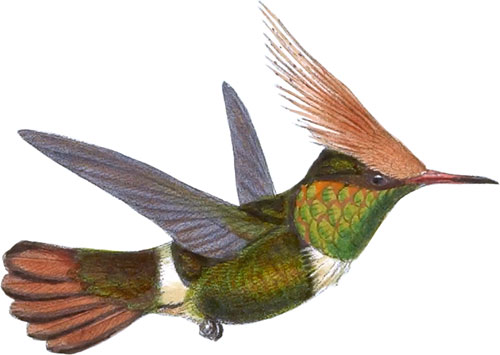Tufted Coquette
Northern Brazil, Guiana, and Trinidad
The Lophornis ornatus does not appear to have been known to Linneus, for I find no mention of it in the 12th or last Edition of his “Systema Naturæ;” a good description of it, however, will be found in the 13th or Gmelin’s Edition; this then appears to be the only member known at that time of a genus now comprising many species, which, for grace and beauty, are second to none in the great family of the Trochilide, and all of which are decorated with elegant, lengthened and spangled neck-plumes, or magnificent crests; the former being most conspicuous in some of the species, while in others, such as L. Regulus and L. Reginæ, the beautiful crest is the more remarkable feature.
The L. ornatus, which is strictly an inhabitant of the lowland districts of tropical America, enjoys a somewhat extensive range over the eastern part of that continent, being found from the Caraccas on the north to Brazil on the south, and particularly numerous in all the intermediate countries, of Demerara, Surinam, and Cayenne; it is also equally abundant on the island of Trinidad. Prince Maximilian of Wied states, that in Brazil he found it on dry and arid plains clothed with a scanty and bushy vegetation; and such would seem to be the habit of the bird in Trinidad, since it there flies around the low flowering shrubs of the open parts of the country, rather than in the more wooded or forest districts.
The nest is a small round cup-shaped structure, composed of some cottony material bound together with cobwebs, and decorated externally with small pieces of lichens and mosses.
So great a similarity reigns among the females of many species of the genus Lophornis, that it is very difficult to distinguish the one from the other, especially as the highly ornamental neck-plumes of the male are entirely absent in the other sex.
The male has the head and crest rich chestnut-red; upper surface and wing-coverts bronzy green; wings dark purplish brown; across the lower part of the back a band of white; rump chestnut-brown; upper tailcoverts bronzy green; tail dark chestnut-red, the two central feathers bronzy green on their apical half, and the lateral ones edged with brownish black; forehead and throat luminous green; on each side of the neck a series of graduated plumes of a light chestnut-red, with a spangle of luminous green at the tip of each; under surface bronzy green; bill fleshy red, dark brown at the tip.
The female has the head and upper surface bronzy green; a narrow band of white across the lower part of the back; upper tail-coverts tipped with bronzy red; tail bronzy green, crossed near the extremity by a broad dusky band and tipped with buff; lores and sides of the throat rufous; centre of the throat buffy white, with a small spot of black at the tip of each feather; an obscure band of white across the breast; under surface bronzy green.
The Plate represents two males and a female of the natural size. The pretty Orchid is copied from a drawing of a Brazilian species kindly sent to me by Mr. Reeves of Rio de Janeiro.
 Lophornis Gouldi
Gould’s Coquette
Lophornis Gouldi
Gould’s Coquette
 Lophornis magnificus
Frilled Coquette
Lophornis magnificus
Frilled Coquette
 Lophornis Regulus
Great-Crested Coquette
Lophornis Regulus
Great-Crested Coquette
 Lophornis Delattrei
DeLattre’s Coquette
Lophornis Delattrei
DeLattre’s Coquette
 Lophornis Reginæ
Spangled Coquette
Lophornis Reginæ
Spangled Coquette
 Lophornis Helenæ
Princess Helena’s Coquette
Lophornis Helenæ
Princess Helena’s Coquette
 Lophornis adorabilis
Salvin’s Coquette
Lophornis adorabilis
Salvin’s Coquette
 Lophornis pavoninus
Roraima Coquette
Lophornis pavoninus
Roraima Coquette
Featuring all 422 illustrated species from John Gould’s A Monograph of the Trochilidæ, or Family of Humming-Birds arranged by color.